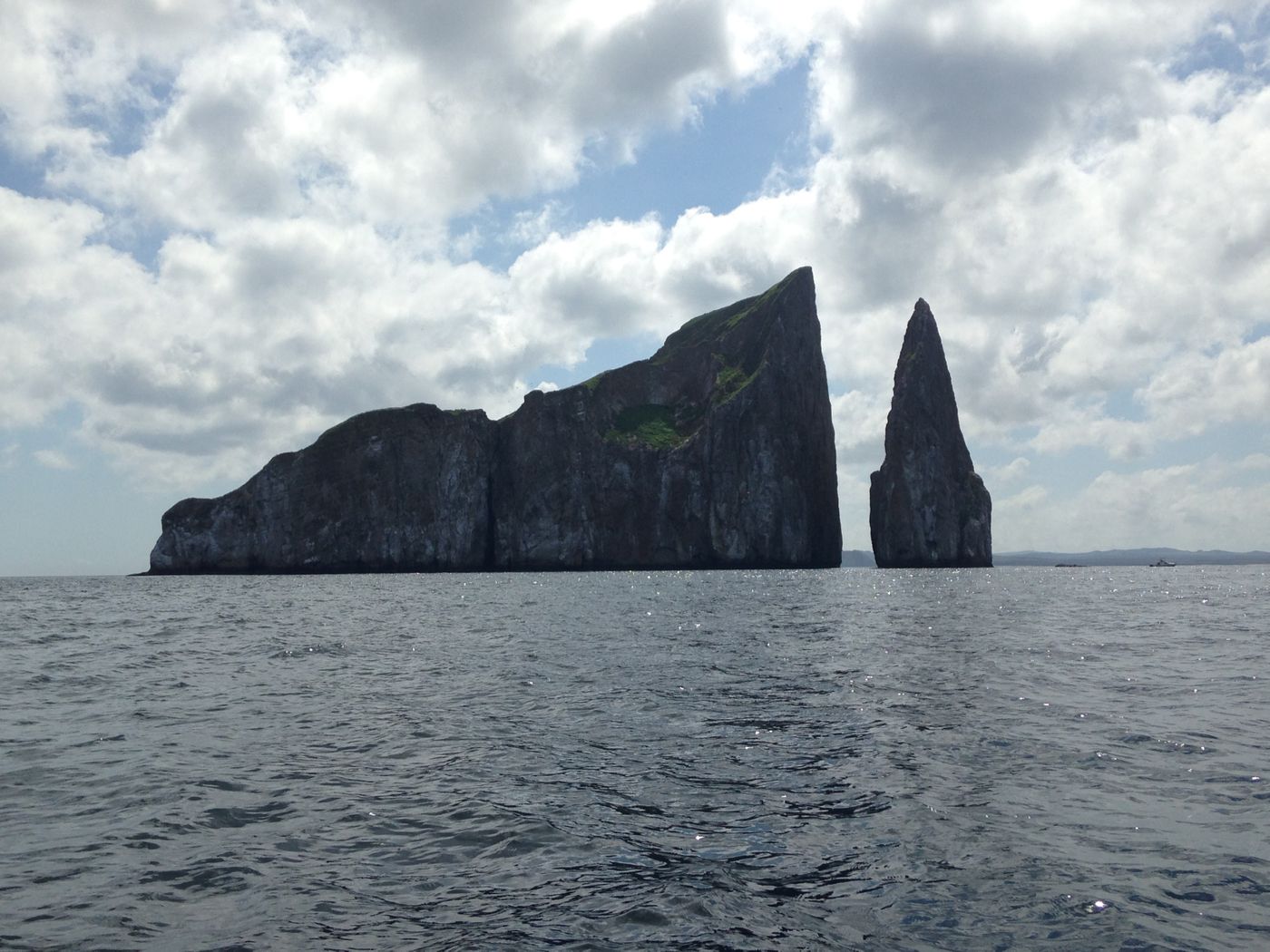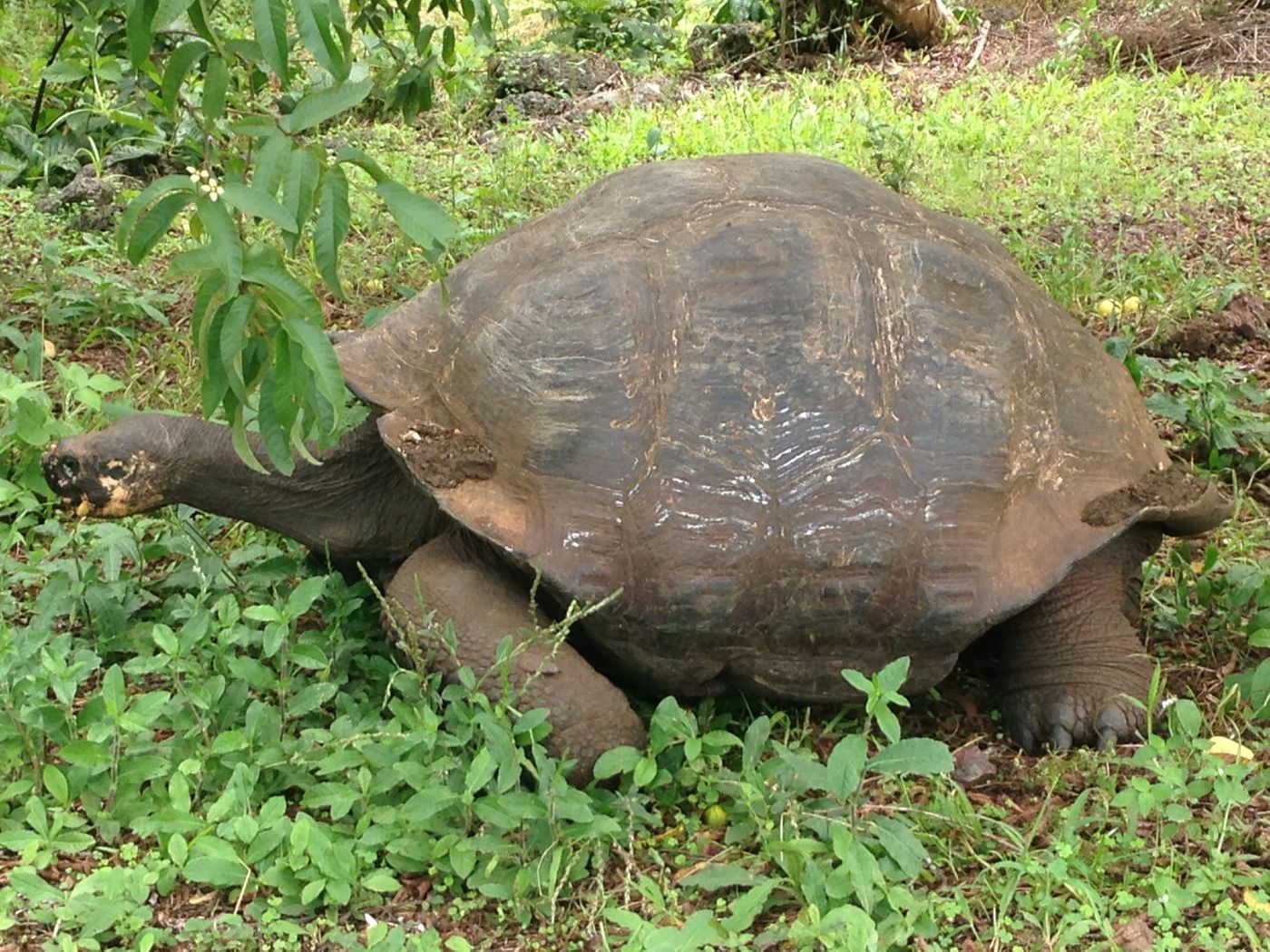Galapagos Discovered
When I first walked off the plane onto the red earth of Baltra Island, I immediately got the feeling that I was in another world. The crunchy rock and cacti scattered in cracks on the earth looked like nothing I had ever seen. And then there was the iguana sunning itself in the middle of the road. I had arrived to the Galapagos.
An archipelago of thirteen large islands and over 120 small islands and marine rocks, the Galapagos (located in the Pacific Ocean west of Ecuador) formed over millions of years from underwater volcanic eruptions. Because of their position atop a volcanic hotspot, which spurts magma from the Earth’s core, to this day some of the islands are still growing. Even more odd to think about is that the islands which lay on the Nazca tectonic plate are moving 3 centimeters per year towards the continent. Geologists estimate that within 50 years, these islands will be one and a half meters closer to the mainland!
The Galapagos are famous as being the birthplace for Charles Darwin’s theory of evolution and natural selection. It was in December of 1831 when Darwin, at aged 22, joined the Beagle as an unpaid naturalist on her five-year journey. While on the islands, Darwin noticed very subtle differences in the birds on each island. Every island had a finch whose beak was just a little bit different from the finches on the other islands. He began to wonder why this would be.
But how did life, let alone the thriving adaptations and evolutionary successes that we see today, even begin on volcanic islands so remote in the middle of the sea? The islands’ location is pinnacle in how life may have started there. Situated at the meeting point of winds and ocean currents coming from the north and south, it is thought that very, very light seeds were carried by the wind to eventually find themselves nestled into crevices on the islands, where the conditions were just right to have allowed germination. Species such as lichens and cacti that were capable of living with very little water were most likely the pioneers for other species.
Other flora and fauna could have arrived to the islands via ocean currents, with most species delineating from South and Central American coasts. Makeshift rafts of vegetation from the mainland could have floated to the islands in approximately two weeks, and those species such as reptiles that can withstand arid conditions could have arrived to the Galapagos in this way. It is for this exact reason that you can’t find amphibians on the islands! They wouldn’t have survived the trip! The ancestors of sea lions and penguins and other marine animals would have been able to swim and float their way to the islands on strong oceans currents.
The confluence of ocean currents is also what creates the productivity of the waters surrounding the islands. The cold Humboldt Current contributes to the South Equatorial Current, producing nutrient rich flows that larger marine life such as whales and dolphins feed on. The warmer Panama Current meets the North Equatorial Countercurrent that allows the perfect conditions for tropical marine ecosystems such as coral reefs. But that’s not all! The Cromwell or Equatorial Undercurrent also comes in from the west, upwelling off the coasts of some of the islands, vertically mixing nutrients and providing food for penguins and flightless cormorants, among others.
Blue footed boobies like the one I captured above in a mating dance thrive on the rich nutrients that current upwellings bring to the islands.
So once all the conditions were right, how did species develop such unique adaptations in the islands? The flightless cormorant that I mentioned probably evolved from normal flying cormorants who flew to the islands, where, lacking predators and with abundant food supplies, they slowly lost the ability to fly. Take the giant tortoises as another example. They are thought to have evolved from tortoises on the mainland. The Galapagos giant tortoises can grow up to three times the size of the mainland tortoises, weighing up to 250 kilos. At one point in time there were 15 different species of Galapagos tortoises, although now only 11 exist. The Galapagos marine iguana is yet another example; it likely diverged from Central America’s black iguana, developing characteristics that allow it to live in coastal zones and swim through the ocean to feed on marine algae. Other species, too, have evolved to the unique habitats on the islands; however, those specific adaptations in such an isolated location left many species particularly vulnerable to the worst kind of predators: humans.
During the 17th and 18th centuries, the islands were a haven for buccaneers, and later in the 19th century, for whalers. These voyages led to the beginning of the exploitation of natural resources, when pirates, sailors, and whalers would remove vast amounts of giant tortoises, whales, and fur seals. This physical removal, although frightening in its consequences of population depletion, was not as destructive as what the sailors left behind. The introduction of non-native species that came on boats threaten the flora and fauna of the Galapagos to this day. The presence on goats and rats, as well as cats, dogs, and cows, led to overgrazing and predation in areas that were otherwise defenseless. In fact, from 1997-2006 there was even a goat eradication program called Project Isabela, responsible for culling the rampant herbivores throughout the islands. Crops introduced for agriculture during the colonization era also caused damage to native ecosystems.
While sea lions used to be hunted, they are now protected by law and curious and playful with visitors.
Introduction of non-native species wasn’t only a problem back in the day. I myself experienced the process that everyone entering and leaving any of the islands must go through in order to ensure that no unwanted species are coming in and no organic artifacts are going out. When I got off the plane, I passed through a soapy welcome mat and was directed to drag my feet on it, so as to clean my shoes. My bags were also checked at every entry and exit point. Yet imagining all the tourists traveling between the islands, it’s easy to see what a difficult task the agricultural security guards are faced with. Seeds transported on shoes or clothing or even in your unknowing ponytail could become the revolution for an unwanted species.
But why is it so important to keep things the way they once were, especially in the place known for its ongoing biological change? That’s a question that spans not just the Galapagos, but as far as the human footprint can reach (and in some cases, as far as our pollution can travel). Considering how anthropogenic influences interact with nature and in return how nature interacts with humans is in our utmost benefit as we continue to comprehend how our decisions affect the planet and its other living beings.
People who call the Galapagos their home are actively asking themselves these questions on a daily basis. Importation of food and clean water, as well as oil and gas for energy, leaves Galapagos residents anxious about sustainable development on the island. Nevertheless, many are committed to growing local crops in the more arable highlands of the populated islands, and there is a sustainable fishing movement taking hold as well. As one resident, Megaly Chaez, of Santa Cruz island says: “Galapagos is in our hands. If we don’t take care of it, who will?”
Sources: Charles Darwin Foundation, San Cristobal Interpretation Center, Radiolab, Galapagos Conservancy











